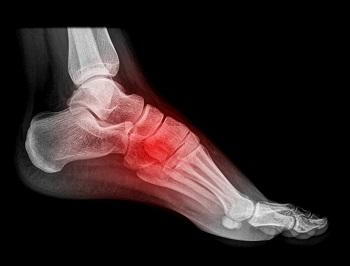Any fracture to the foot or ankle should be taken seriously, but a Lisfranc fracture is particularly concerning for podiatrists. Because the fracture happens at the center of the foot where there are many connections, without prompt treatment this problem can significantly reduce your ability to walk or participate in athletic activities. The lenger the fracture goes untreated the less likely the outcome will be favorable. Learn more about Lisfranc fractures to see if this might be the foot problem you're experiencing.
the foot where there are many connections, without prompt treatment this problem can significantly reduce your ability to walk or participate in athletic activities. The lenger the fracture goes untreated the less likely the outcome will be favorable. Learn more about Lisfranc fractures to see if this might be the foot problem you're experiencing.
What Is a Lisfranc Fracture?
When the bones at the center of the foot become fractured, broken or shift out of place it is called a Lisfranc injury. The ligaments that hold the bones together and cartilage at joints can also tear. This can happen when a heavy object falls on the foot, the patient has a bad fall or the foot twists unnaturally. Athletes, like soccer and football players, may be at risk for Lisfranc fractures. Doctors will expect a Lisfranc injury after a car accident or truamatice event, but lisfranc injuries can even happen during atletic activies and not be so obvious.
Why It’s a Concern
A Lisfranc fracture is a major concern for podiatrists because if it is allowed to go untreated for an extended period of time it can lead to a disability of the foot. It can cause the bottom of the foot to swell, bruise and become darkly discolored (a telltale sign of a Lisfranc fracture). It can also be a very painful condition that is difficult to ignore.
Lisfranc Fracture Treatments
Your foot doctor will take X-rays to confirm that you have a Lisfranc injury. If so, conservative treatments may be implemented first, including wearing a removable cast or an orthotic device that will train your bones and joints into a position for healing. In a severe case where there’s a clear fracture or severe subluxation of the bones, you may have to have foot surgery. Two common surgical solutions are fusion (healing the bones together) and internal fixation (involves the use of screws and other devices to repair the foot).
Talk to a Podiatrist
If you are having foot pain please see your podiatris. The earlier you seek treatment for a Lisfranc fracture, the better for your long-term foot health. Your podiatrist will discuss your options and come up with an ideal plan for fixing the problem.
Sincerly,
Advanced Foot and Ankle
972.542.2155
